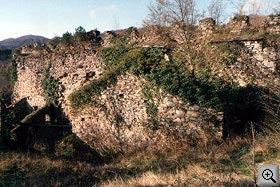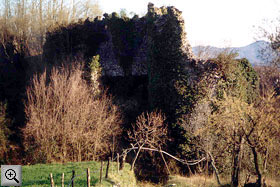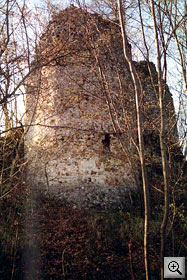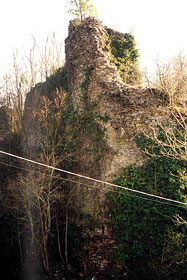Bigliolo Castle
 |
 |
Left: The north walls. |
Bigliolo it's a small suburb of the Aulla's Municipality, in province of Massa-Carrara. It is located in the low Lunigiana and it's reachable, from Aulla, following the SS63 of the Cerreto until Serricciolo and then the indications you can find along the main provincial road.
Bigliolo, after this dispute, ended up in the hold of the Marquis of Filattiera and precisely to Bernab� Malaspina, a cruel persecutor of the diocese of Luni. These were in herited by his son Francesco. Official documents of the division of 1275 attest that Francesco, the originator of the Olivola lineage was assigned among other things, also all that the family possessed in 'Castro Bilioli' � (Ugo Formentini). 'The castle of Olivola was chosen as the main town in the vast Fief because it was less vulnerable and positioned almost in the center of the feudal domain comprising Aulla-Terrarossa-Virgoletta-Pieve di Monti Licciana-Varano-Groppo San Pietro-Bastia-Agnino-Bigliolo and Pallerone' ... (C. Caselli).
 |
|
East Tower
|
In 1467 Bigliolo passed to Marquis Gabriele Malaspina of Fosdinovo. Until 1510, when upon his death his son Lazzaro I, with division of the Fief according to the well known law of succession of the Malaspina's, would give rise to the second dynasty of the Marquis of Olivola. A tragic moment for the Castle of Bigliolo took place in 1523, when Giovanni dei Medici, known as 'Bande Nere' (Black Gangs), acquired the Fief of Aulla, but it was not confirmed on him by the Emperor, attempted to construct a Fief in Lunigiana, attacking various Castles. Bigliolo was among those, as Bastia, that resisted, and where the 'Bande Nere' ordered massacres and unspeakable atrocities. The bloody siege of Bigliolo took place after the battle of Bibola where approximately 700 soldiers of Giovanni of the 'Bande Nere' got the better of the 2000 soldiers of the Malaspina's. Among these were no doubt some men from Bigliolo. Giovanni of the 'Bande Nere' upon the council of the Bishop of Pistoia, sent by Pope Clement VII (the Pope of the Anglicanscism), son of Giuliano dei Medici, made peace with the Malaspina's and receiving 2500 gold 'scudi' left the area.
 |
|
West Tower
|
From this moment on the castle of Bigliolo started to
decline, as an inhabited center homes emerged in the plain, although
it conserved it's prestigious position because it continued to administer
justice and convene assemblies. On 14/11/1568, with a contract drawn
up by the notary Giovanni Michele dei Cerri of Bigliolo, the sons of
Lazzaro I divided the Marquisdom in two parts, one comprising Pallerone
with Canova assigned to Spinetta and Carlo and the other comprising Olivola
with Bigliolo assigned to Camillo and Troilo. This gave rise to a collective
governing system, in which the two Marquise landlords would alternate
for a year, one after the other in governing their assigned share. The
desire to conserve the essential unity of the Fief would induce Camillo,
Carlo, and Troilo, bachelors, to stipulate a regular notary act of succession
on 10/3/1572, in order that Spinetta, the only one to be married with
children, could guarantee the continuity of the dynasty inaugurated by
Lazzaro I. During the Napoleonic period the lands of Lunigiana became
part, with the edict 2/7/1797, of the Republic of Cisalpina.
With the congress of Vienna, after the fall of Napoleon, the Lunigiana
was awarded to Maria Beatrice d' Este who in turn entrusted it to her
son Francesco IV Duke of Modena and it was known as Lunigiana Estense.
Francesco V succeeded his father in 1846, but was driven out in March
of 1848. That same year the population voted for annexation to Tuscany
or Piedmont. Bigliolo and other towns declared that they wished to govern
themselves. They united with Fivizzano and the Granduchy of Tuscany and
after the peace of Villafranca in Veneto, on 23/3/1860 with the annexation
of Tuscany to Piedmont they became their subjects.
| Back to Homepage |
| Back to Castles Index |